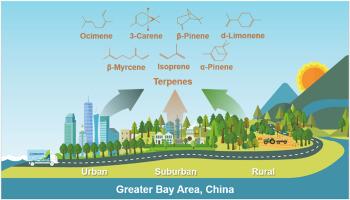Mobile monitoring of atmospheric terpene dynamics across the subtropical megacities Greater Bay Area
IF 3.4
Q2 ENVIRONMENTAL SCIENCES
引用次数: 0
Abstract
Currently, the relative importance of anthropogenic versus biogenic terpenes in subtropical megacities of developing countries remains poorly understood, particularly in rapidly urbanizing regions like the China's Greater Bay Area (GBA), characterized by high population density, intensive industrial activity, and subtropical climate favoring both emission sources. Herein, we provide spatially resolved measurements of ambient terpenes (isoprene and six monoterpenes) in the GBA, employing a vehicle-mounted platform across diverse land-use zones (urban, suburban and rural) during autumn 2022. Results showed total terpene concentrations averaged 0.922 ± 0.280 ppbv, with isoprene and α-pinene dominating (>80 %). Diurnal variations revealed monoterpenes peaking in early morning in urban areas, likely linked to volatile chemical products (VCPs) and residential cooking, whereas isoprene exhibited midday maxima driven by biogenic emissions. Strong correlations with anthropogenic tracers indicated significant co-emissions. Positive Matrix Factorization (PMF) source apportionment quantified VCPs as the primary urban source for monoterpenes, while industrial activities dominated suburban regions. Biogenic emissions prevailed in rural zones but were overshadowed by anthropogenic influences in urbanized areas. These findings underscore the pivotal role of anthropogenic sources in shaping terpene dynamics in subtropical megacities, and emphasizes the need for region-specific terpene emission inventories and targeted control strategies for the GBA and analogous regions globally.

大湾区亚热带特大城市大气萜烯动态的移动监测
目前,人们对发展中国家亚热带特大城市中人为萜烯与生物萜烯的相对重要性仍知之甚少,特别是在中国大湾区等快速城市化地区,这些地区具有人口密度高、工业活动密集、亚热带气候有利于两种排放源的特点。本文采用车载平台,于2022年秋季对大湾区不同土地利用区(城市、郊区和农村)的环境萜烯(异戊二烯和六单萜烯)进行了空间分辨测量。结果:总萜平均浓度为0.922±0.280 ppbv,以异戊二烯和α-蒎烯为主(占80%)。日变化表明,单萜烯在城市地区清晨达到峰值,可能与挥发性化学产品(vcp)和居民烹饪有关,而异戊二烯则在中午达到峰值,受生物源排放驱动。与人为示踪剂的强相关性表明了显著的共排放。正矩阵分解(PMF)源分配量化了vcp是城市单萜烯的主要来源,而工业活动在郊区占主导地位。生物源性排放在农村地区普遍存在,但在城市化地区被人为影响所掩盖。这些发现强调了人为源在塑造亚热带特大城市萜烯动态方面的关键作用,并强调了在大湾区和全球类似区域建立区域特定萜烯排放清单和有针对性的控制策略的必要性。
本文章由计算机程序翻译,如有差异,请以英文原文为准。
求助全文
约1分钟内获得全文
求助全文
来源期刊

Atmospheric Environment: X
Environmental Science-Environmental Science (all)
CiteScore
8.00
自引率
0.00%
发文量
47
审稿时长
12 weeks
 求助内容:
求助内容: 应助结果提醒方式:
应助结果提醒方式:


